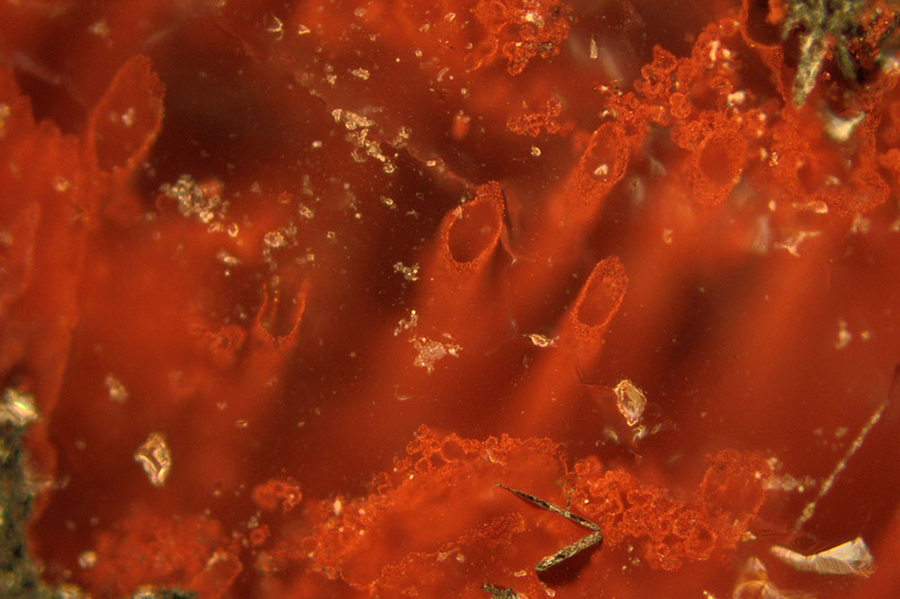Are Canadian fossils evidence of the oldest form of life yet seen?
Loading...
Recently discovered microfossils make dinosaur bones look fresh, according to a team of scientists from University College London.
Ultrafine fibers and tubes a fraction as wide as a human hair may represent the earliest signs of life on Earth. A paper published Wednesday in the journal Nature presented evidence that the structures are biological, anticipating the controversy that inevitably surrounds each new claim of earliest life. If confirmed, the discovery could push back the start date for life to the geological dawn on Earth, which would have repercussions on the search for life on Mars as well.
"I thought to myself 'we've got it, we've got the oldest fossils on the planet,' ” recounted Dominic Papineau of UCL, who discovered the fossils, in an interview with the BBC.
The samples came from a geological formation in northern Canada called Nuvvuagittuq. First surveyed in the 1990s, the quartz-rich crust’s age is under debate with estimates ranging from 3.77 billion years to 4.22 billion years ago, making the Nuvvuagittuq crust some of the oldest rocks ever discovered.
The crust is thought to have once been part of the ocean floor, where hydrothermal vents spewed hot, chemically rich jets of water. Team members say the fossil tubes and filaments discovered resemble similar structures left behind by the microbes that live in such environments today, feeding on iron and other minerals.
Based on the age of the deposits surrounding the structures, the team concluded that microbes that created them were at least 300 million years older than the widely accepted 3.4 to 3.5 billion-year-old evidence of earliest life.
If the quartz falls closer to the older end of the range, the revision would be even more dramatic, suggesting "an almost instantaneous emergence of life" after ocean formation 4.4 billion years ago, first author Matthew Dodd explained in a press release.
Such vast time scales can be hard to visualize, so the BBC compressed Earth’s entire 4.5 billion year timeline into a single day. On such a timeline, these newly discovered fossils would emerge after just a few hours, between 3 and 5 a.m. By way of comparison, dinosaurs lived between 10 and 11 p.m. and humans evolved in the final seconds of the day.
But extraordinary claims require extraordinary evidence, and some experts aren’t convinced the UCL team has found what they claim.
Frances Westall, the director of research at the CNRS-Centre de Biophysique Moléculaire in Orléans, France, is one of the skeptics. “I am frankly dubious,” she told The New York Times.
Dr. Westwall also studies early microbes and has found that they tend to leave behind much smaller tubes, their growth constrained by the lack of oxygen on primordial Earth.
Other experts aren’t convinced the types originated from biological causes.
"The morphology of these argued iron-oxidising filaments from Northern Canada is not convincing," Dr. Nicola McLoughlin of Rhodes University in South Africa told BBC News. "In recent deposits we see spectacular twisted stalks, often arranged in layers, but in the highly metamorphosed rocks of the Nuvvuagittuq belt the filaments are much simpler in shape."
Scientists won’t settle the debate anytime soon, but regardless of the outcome the trend of discovering ever earlier evidence of life is clear. The mark to beat became 3.5 billion years in 2013, and just six months ago a team of Australians claimed evidence dating back 3.7 billion years, butting right up against the lower limit of the UCL study.
The idea that life developed so quickly, and in such a harsh environment raises hopes for someday finding similar signs on Mars, which was a similarly warm, wet planet billions of years ago.
“These discoveries demonstrate life developed on Earth at a time when Mars and Earth had liquid water at their surfaces, posing exciting questions for extraterrestrial life. Therefore, we expect to find evidence for past life on Mars [4 billion] years ago, or if not, Earth may have been a special exception,” said Mr. Dodd.
A clearer understanding of the traces left behind by ancient life could also help focus the search for life on Mars, say some experts. The study was partially funded by NASA.
Ultimately, the researchers suggest the study of early life has a meaning that extends beyond its practical applications in astrobiology.
As Dr. Papineau told the BBC: "It relates to our origins. For intelligent life to evolve to a level of consciousness, to a point where it traces back its history to understand its own origin - that's inspirational."








